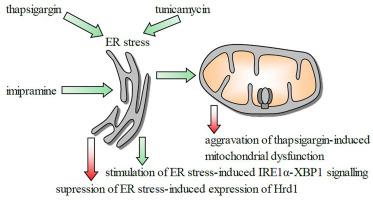European Journal of Pharmacology ( IF 4.2 ) Pub Date : 2021-03-31 , DOI: 10.1016/j.ejphar.2021.174073 Maria Brodnanova 1 , Zuzana Hatokova 2 , Andrea Evinova 2 , Michal Cibulka 2 , Peter Racay 1

|
The aim of our work was to study effect of antidepressant imipramine on both thapsigargin- and tunicamycin-induced ER stress and mitochondrial dysfunction in neuroblastoma SH-SY5Y cells. ER stress in SH-SY5Y cells was induced by either tunicamycin or thapsigargin in the presence or absence of imipramine. Cell viability was tested by the MTT assay. Splicing of XBP1 mRNA was studied by RT-PCR. Finally, expression of Hrd1 and Hsp60 was determined by western blot analysis.
Our findings provide evidence that at high concentrations imipramine potentiates ER stress-induced death of SH-SY5Y cells. The effect of imipramine on ER stress-induced death of SH-SY5Y cells was stronger in combination of imipramine with thapsigargin. In addition, we have found that treatment of SH-SY5Y cells with imipramine in combination of either thapsigargin or tunicamycin is associated with the alteration of ER stress-induced IRE1α-XBP1 signalling. Despite potentiation of ER stress-induced XBP1 splicing, imipramine suppresses both thapsigargin- and tunicamycin-induced expression of Hrd1. Finally, imipramine in combination with thapsigargin—but not tunicamycin—aggravates ER stress-induced mitochondrial dysfunction without significant impact on intracellular mitochondrial content as indicated by the unaltered expression of Hsp60.
Our results indicate the possibility that chronic treatment with imipramine might be associated with a higher risk of development and progression of neurodegenerative disorders, in particular those allied with ER stress and mitochondrial dysfunction like Parkinson’s and Alzheimer’s disease.
中文翻译:

丙咪嗪对毒胡萝卜素和衣霉素诱导的神经母细胞瘤 SH-SY5Y 细胞内质网应激和线粒体功能障碍的不同影响
我们工作的目的是研究抗抑郁药丙咪嗪对毒胡萝卜素和衣霉素诱导的神经母细胞瘤 SH-SY5Y 细胞内质网应激和线粒体功能障碍的影响。在丙咪嗪存在或不存在的情况下,衣霉素或毒胡萝卜素诱导 SH-SY5Y 细胞中的 ER 应激。通过MTT测定测试细胞活力。通过RT-PCR研究XBP1 mRNA的剪接。最后,通过蛋白质印迹分析确定 Hrd1 和 Hsp60 的表达。
我们的研究结果提供证据表明,高浓度丙咪嗪可增强内质网应激诱导的 SH-SY5Y 细胞死亡。丙咪嗪与毒胡萝卜素联合使用时丙咪嗪对内质网应激诱导的 SH-SY5Y 细胞死亡的影响更强。此外,我们发现用丙咪嗪联合毒胡萝卜素或衣霉素处理 SH-SY5Y 细胞与内质网应激诱导的 IRE1α-XBP1 信号传导的改变有关。尽管内质网应激诱导的 XBP1 剪接增强,丙咪嗪抑制毒胡萝卜素和衣霉素诱导的 Hrd1 表达。最后,丙咪嗪与毒胡萝卜素(而不是衣霉素)联合使用会加重内质网应激诱导的线粒体功能障碍,而对细胞内线粒体含量没有显着影响,如 Hsp60 的未改变表达所示。
我们的结果表明,丙咪嗪的长期治疗可能与神经退行性疾病的发生和进展风险较高有关,尤其是那些与 ER 应激和线粒体功能障碍(如帕金森病和阿尔茨海默病)相关的疾病。


















































 京公网安备 11010802027423号
京公网安备 11010802027423号